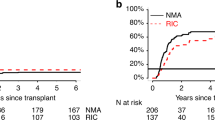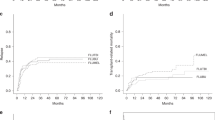Abstract
Disease relapse following an allogeneic transplant remains a major cause of treatment failure, often with a poor outcome. Second allogeneic transplant procedures have been associated with high TRM, especially with myeloablative conditioning. We hypothesized that the use of reduced-intensity conditioning (RIC) would decrease the TRM. We performed a retrospective national multicentre analysis of 71 patients receiving a second allogeneic transplant using RIC after disease relapse following an initial allogeneic transplant. The majority of patients had leukaemia/myelodysplasia (MDS) (N=57), nine had lymphoproliferative disorders, two had myeloma and three had myeloproliferative diseases. A total of 25% of patients had unrelated donors. The median follow-up was 906 days from the second allograft. The predicted overall survival (OS) and TRM at 2 years were 28 and 27%, respectively. TRM was significantly lower in those who relapsed late (>11 months) following the first transplant (2 years: 17 vs 38% in early relapses; P=0.03). Two factors were significantly associated with a better survival: late relapse (P=0.014) and chronic GVHD following the second transplant (P=0.014). These data support our hypothesis that the second RIC allograft results in a lower TRM than using MA. A proportion of patients achieved a sustained remission even when relapsing after a previous MA transplant.
This is a preview of subscription content, access via your institution
Access options
Subscribe to this journal
Receive 12 print issues and online access
$259.00 per year
only $21.58 per issue
Buy this article
- Purchase on Springer Link
- Instant access to full article PDF
Prices may be subject to local taxes which are calculated during checkout




Similar content being viewed by others
References
Kahl C, Storer BE, Sandmaier BM, Mielcarek M, Maris MB, Blume KG et al. Relapse risk in patients with malignant diseases given allogeneic hematopoietic cell transplantation after nonmyeloablative conditioning. Blood 2007; 110: 2744–2748.
Bosi A, Laszlo D, Labopin M, Reffeirs J, Michallet M, Gluckman E et al. Second allogeneic bone marrow transplantation in acute leukemia: results of a survey by the european cooperative group for blood and marrow transplantation. J Clin Oncol 2001; 19: 3675–3684.
Shaw BE, Russell NH . Treatment options for the management of acute leukaemia relapsing following an allogeneic transplant. Bone Marrow Transplant 2008; 41: 495–503.
Arellano ML, Langston A, Winton E, Flowers CR, Waller EK . Treatment of relapsed acute leukemia after allogeneic transplantation: a single center experience. Biol Blood Marrow Transplant 2007; 13: 116–123.
Levine JE, Braun T, Penza SL, Beatty P, Cornetta K, Martino R et al. Prospective trial of chemotherapy and donor leukocyte infusions for relapse of advanced myeloid malignancies after allogeneic stem-cell transplantation. J Clin Oncol 2002; 20: 405–412.
Mielcarek M, Storer BE, Flowers ME, Storb R, Sandmaier BM, Martin PJ . Outcomes among patients with recurrent high-risk hematologic malignancies after allogeneic hematopoietic cell transplantation. Biol Blood Marrow Transplant 2007; 13: 1160–1168.
Kolb HJ, Schattenberg A, Goldman JM, Hertenstein B, Jacobsen N, Arcese W et al. Graft-versus-leukemia effect of donor lymphocyte transfusions in marrow grafted patients. European group for blood and marrow transplantation working party chronic leukemia. Blood 1995; 86: 2041–2050.
Bethge WA, Hegenbart U, Stuart MJ, Storer BE, Maris MB, Flowers ME et al. Adoptive immunotherapy with donor lymphocyte infusions after allogeneic hematopoietic cell transplantation following nonmyeloablative conditioning. Blood 2004; 103: 790–795.
Russell NH, Byrne JL, Faulkner RD, Gilyead M, Das-Gupta EP, Haynes AP . Donor lymphocyte infusions can result in sustained remissions in patients with residual or relapsed lymphoid malignancy following allogeneic haemopoietic stem cell transplantation. Bone Marrow Transplant 2005; 36: 437–441.
Peggs KS, Thomson K, Hart DP, Geary J, Morris EC, Yong K et al. Dose-escalated donor lymphocyte infusions following reduced intensity transplantation: toxicity, chimerism, and disease responses. Blood 2004; 103: 1548–1556.
Shaw BE, Byrne JL, Das-Gupta E, Carter GI, Russell NH . The impact of chimerism patterns and predonor leukocyte infusion lymphopenia on survival following T cell-depleted reduced intensity conditioned transplants. Biol Blood Marrow Transplant 2007; 13: 550–559.
Wolff SN . Second hematopoietic stem cell transplantation for the treatment of graft failure, graft rejection or relapse after allogeneic transplantation. Bone Marrow Transplant 2002; 29: 545–552.
Slavin S, Nagler A, Naparstek E, Kapelushnik Y, Aker M, Cividalli G et al. Nonmyeloablative stem cell transplantation and cell therapy as an alternative to conventional bone marrow transplantation with lethal cytoreduction for the treatment of malignant and nonmalignant hematologic diseases. Blood 1998; 91: 756–763.
Riddell SR, Berger C, Murata M, Randolph S, Warren EH . The graft versus leukemia response after allogeneic hematopoietic stem cell transplantation. Blood Rev 2003; 17: 153–162.
Khouri IF, Keating M, Korbling M, Przepiorka D, Anderlini P, O'Brien S et al. Transplant-lite: induction of graft-versus-malignancy using fludarabine-based nonablative chemotherapy and allogeneic blood progenitor-cell transplantation as treatment for lymphoid malignancies. J Clin Oncol 1998; 16: 2817–2824.
Branson K, Chopra R, Kottaridis PD, McQuaker G, Parker A, Schey S et al. Role of nonmyeloablative allogeneic stem-cell transplantation after failure of autologous transplantation in patients with lymphoproliferative malignancies. J Clin Oncol 2002; 20: 4022–4031.
Pawson R, Potter MN, Theocharous P, Lawler M, Garg M, Yin JA et al. Treatment of relapse after allogeneic bone marrow transplantation with reduced intensity conditioning (FLAG±Ida) and second allogeneic stem cell transplant. Br J Haematol 2001; 115: 622–629.
Sica RA, Vosganian GS, Tuscano JM, Law LY, Richman CM . Reduced intensity stem cell transplant (RIST) as salvage treatment for relapse following myeloablative allogeneic transplantation in adult acute myeloid leukemia (abstract). Biol Blood Marrow Transplant 2007; 13: 367.
Michallet M, Tanguy ML, Socie G, Thiebaut A, Belhabri A, Milpied N et al. Second allogeneic haematopoietic stem cell transplantation in relapsed acute and chronic leukaemias for patients who underwent a first allogeneic bone marrow transplantation: a survey of the societe francaise de greffe de moelle (SFGM). Br J Haematol 2000; 108: 400–407.
Bosi A, Bacci S, Miniero R, Locatelli F, Laszlo D, Longo G et al. Second allogeneic bone marrow transplantation in acute leukemia: a multicenter study from the gruppo italiano trapianto di midollo osseo (GITMO). Leukemia 1997; 11: 420–424.
Eapen M, Giralt SA, Horowitz MM, Klein JP, Wagner JE, Zhang MJ et al. Second transplant for acute and chronic leukemia relapsing after first HLA-identical sibling transplant. Bone Marrow Transplant 2004; 34: 721–727.
Munoz A, Badell I, Olive T, Verdeguer A, Gomez P, Bureo E . Second allogeneic hematopoietic stem cell transplantation in hematologic malignancies in children: long-term results of a multicenter study of the spanish working party for bone marrow transplantation in children (GETMON). Haematologica 2002; 87: 331–332.
Kishi K, Takahashi S, Gondo H, Shiobara S, Kanamaru A, Kato S et al. Second allogeneic bone marrow transplantation for post-transplant leukemia relapse: results of a survey of 66 cases in 24 Japanese institutes. Bone Marrow Transplant 1997; 19: 461–466.
Shaw BE, Russell NH, Devereux S, Das-Gupta E, Mackinnon S, Madrigal JA et al. The impact of donor factors on primary non-engraftment in recipients of reduced intensity conditioned transplants from unrelated donors. Haematologica 2005; 90: 1562–1569.
Shimoni A, Kroger N, Zabelina T, Ayuk F, Hardan I, Yeshurun M et al. Hematopoietic stem-cell transplantation from unrelated donors in elderly patients (age >55 years) with hematologic malignancies: older age is no longer a contraindication when using reduced intensity conditioning. Leukemia 2005; 19: 7–12.
Wong R, Giralt SA, Martin T, Couriel DR, Anagnostopoulos A, Hosing C et al. Reduced-intensity conditioning for unrelated donor hematopoietic stem cell transplantation as treatment for myeloid malignancies in patients older than 55 years. Blood 2003; 102: 3052–3059.
Schmid C, Labopin M, Finke J, Ehninger G, Ringden O, Niederwieser D et al. Retrospective comparison of using or not using donor lymphocyte transfusion in the treatment of hematological relapse after allogeneic stem cell transplantation in 489 adults with acute myeloid leukemia (abstract). Blood 2004; 104: 298.
Lee JH, Lee KH, Kim S, Seol M, Kim SH, Kim WK et al. Combination chemotherapy of intermediate-dose cytarabine, idarubicin, plus etoposide and subsequent mobilized donor leukocyte infusion for relapsed acute leukemia after allogeneic bone marrow transplantation. Leuk Res 2001; 25: 305–312.
Huff CA, Fuchs EJ, Smith BD, Blackford A, Garrett-Mayer E, Brodsky RA et al. Graft-versus-host reactions and the effectiveness of donor lymphocyte infusions. Biol Blood Marrow Transplant 2006; 12: 414–421.
Choi SJ, Lee JH, Kim S, Seol M, Lee YS, Lee JS et al. Treatment of relapsed acute myeloid leukemia after allogeneic bone marrow transplantation with chemotherapy followed by G-CSF-primed donor leukocyte infusion: a high incidence of isolated extramedullary relapse. Leukemia 2004; 18: 1789–1797.
Schmid C, Schleuning M, Schwerdtfeger R, Hertenstein B, Mischak-Weissinger E, Bunjes D et al. Long-term survival in refractory acute myeloid leukemia after sequential treatment with chemotherapy and reduced-intensity conditioning for allogeneic stem cell transplantation. Blood 2006; 108: 1092–1099.
Choi SJ, Lee JH, Kim S, Lee YS, Seol M, Ryu SG et al. Treatment of relapsed acute lymphoblastic leukemia after allogeneic bone marrow transplantation with chemotherapy followed by G-CSF-primed donor leukocyte infusion: a prospective study. Bone Marrow Transplant 2005; 36: 163–169.
Collins Jr RH, Goldstein S, Giralt S, Levine J, Porter D, Drobyski W et al. Donor leukocyte infusions in acute lymphocytic leukemia. Bone Marrow Transplant 2000; 26: 511–516.
Kolb HJ . Donor leukocyte transfusions for treatment of leukemic relapse after bone marrow transplantation. EBMT immunology and chronic leukemia working parties. Vox Sang 1998; 74 (Suppl 2): 321–329.
Acknowledgements
We thank all of the UK transplant teams who have contributed patients to this study.
Author information
Authors and Affiliations
Corresponding author
Rights and permissions
About this article
Cite this article
Shaw, B., Mufti, G., Mackinnon, S. et al. Outcome of second allogeneic transplants using reduced-intensity conditioning following relapse of haematological malignancy after an initial allogeneic transplant. Bone Marrow Transplant 42, 783–789 (2008). https://doi.org/10.1038/bmt.2008.255
Received:
Revised:
Accepted:
Published:
Issue Date:
DOI: https://doi.org/10.1038/bmt.2008.255



